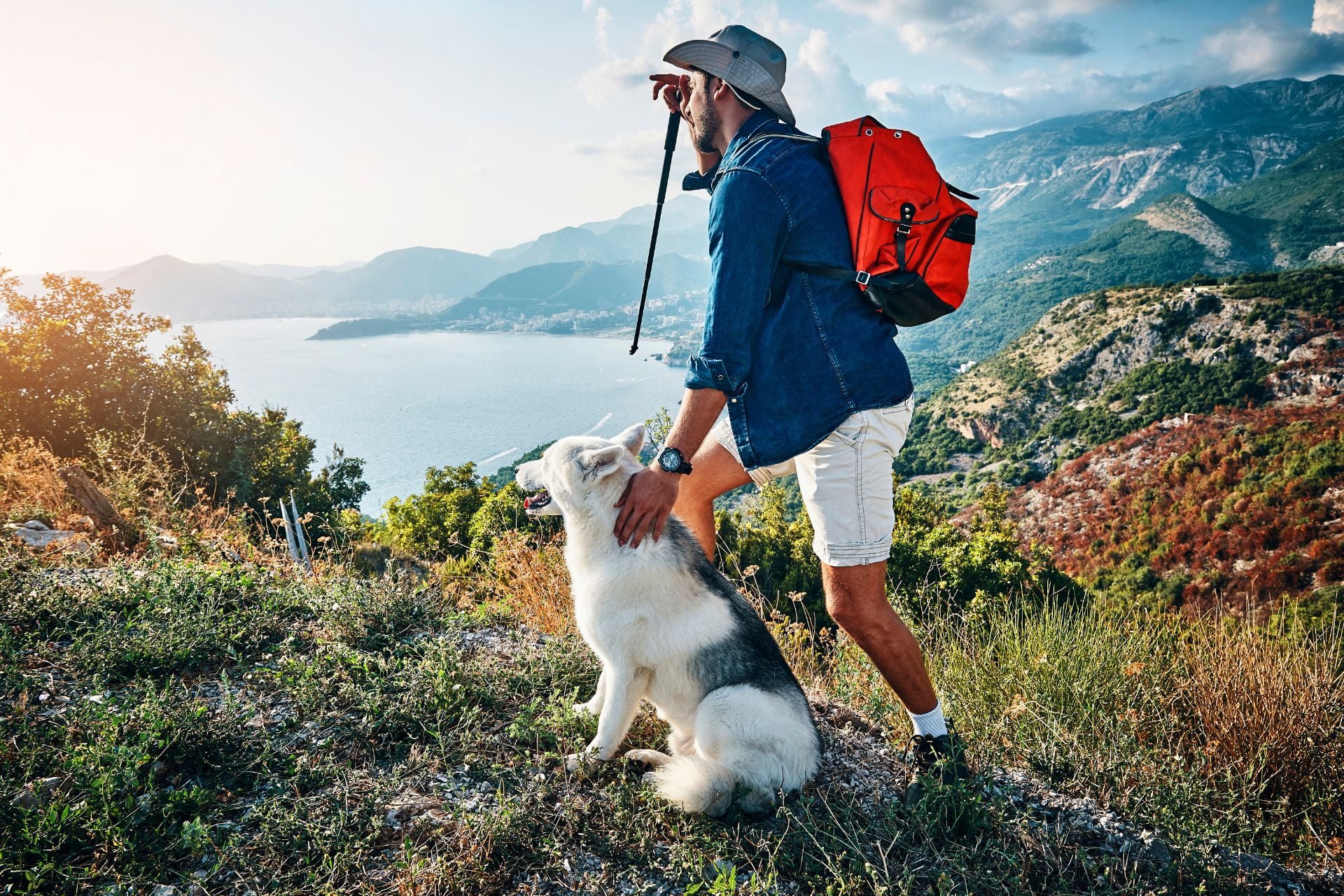Hiking with your dog isn’t just a walk in the park—it’s an adventure that strengthens your bond, keeps you both active, and lets your pup explore a world of new sights and smells. But before you grab the leash and hit the trail, it’s important to plan ahead. From packing the right gear to training your dog to be a trail pro, this guide has everything you need for a pawsome (oops, we mean fantastic) outdoor adventure.
Step 1: Prep Like a Pro
Before you set out on your adventure, it’s crucial to lay the groundwork for a smooth and enjoyable hike. Preparation isn’t just about packing snacks—it’s about ensuring both you and your dog are ready to tackle the trail safely and confidently.
Pick the Right Trail
Not all trails are created equal, and not all are dog-friendly. Start by researching trails in your area and look for ones that match your dog’s abilities and experience level. If your pup is new to hiking or hasn’t built up endurance, opt for short, flat trails with minimal obstacles. As they become more comfortable and fit, you can gradually increase the difficulty with longer hikes, steeper inclines, or uneven terrain.
Consider the trail surface as well. Rocky paths, hot asphalt, or rough gravel can be tough on sensitive paws. Check trail reviews or photos online to get an idea of what to expect.
Do Your Homework on Trail Rules
Every trail has its own set of guidelines when it comes to pets. Some require dogs to be on a leash at all times, while others allow off-leash walking if your pup has reliable recall skills. You may also encounter trails where dogs aren’t allowed at all due to sensitive wildlife or environmental concerns. Checking these rules ahead of time avoids disappointment—and keeps you and your dog out of trouble.
Bonus tip: Always bring a leash, even if you’re heading to an off-leash area. You never know when you might need to restrain your dog quickly, whether it’s for their safety or to avoid a run-in with other hikers or animals.
Visit the Vet for a Quick Check-Up
Ensure their vaccinations are current, especially for diseases like rabies and leptospirosis, which can be a risk in wooded or water-heavy areas. Talk to your vet about flea, tick, and heartworm prevention, as these pesky critters love hitching a ride on adventurous pups.
If your dog has a chronic condition, is older, or has never done strenuous exercise, your vet can offer advice on how much activity they can safely handle. You’ll also want to discuss any medications they might need, like pain relief for sore joints after a long hike.
Build Your Dog’s Stamina
If your dog is more of a couch potato than a trailblazer, don’t expect them to tackle a 10-mile trek on their first outing. Just like humans, dogs need time to build strength and endurance. Start with walks around your neighborhood, gradually increasing distance and duration. As your pup gets fitter, introduce hikes with mild inclines or uneven terrain to prepare them for the real deal.
Pay attention to how your dog reacts during these practice outings. Are they keeping up? Do they seem eager to continue? Or are they dragging their paws after a mile? This will give you a clear idea of their current limits.
Pack Smart and Plan Ahead
Preparation goes beyond choosing the right trail. Think about the logistics of your hike:
- Time It Right: Avoid the hottest parts of the day, especially in summer. Early mornings or late afternoons are often cooler and less crowded.
- Check the Weather: Rain or extreme heat can turn a pleasant outing into a disaster. Adjust your plans as needed to keep your dog safe and comfortable.
- Know the Route: Familiarize yourself with the trail map and note key landmarks, water sources, or rest areas. Being prepared helps you stay focused on enjoying the hike, not scrambling for directions.
Step 2: Gear Up, Pup Style
Hiking is a team effort, and your dog needs their own gear to stay safe and comfy. Here’s what to pack:
- Leash & Harness: A secure, well-fitting harness is a must. Bonus points if it has reflective material for visibility.
- Collapsible Water Bowl: Staying hydrated is key, so bring a bowl your dog can drink from on the go.
- Poop Bags: Trails are no place for doggy surprises—pick it up and pack it out.
- First Aid Kit: Be ready for anything with bandages, antiseptic wipes, and tweezers for splinters or ticks.
Step 3: Train for Trail Life
Before you and your pup hit the trail, some training is essential to keep things safe and enjoyable. A few basics will make all the difference in managing distractions, avoiding hazards, and ensuring your dog is a trail pro.
Nail the Basics
Commands like “sit,” “stay,” “come,” and “leave it” are must-haves for hiking. These cues can prevent your dog from chasing wildlife or getting into dangerous situations. If you’re starting from scratch, check out this guide on the 6 Basic Commands for Puppies for tips on building a strong foundation.
Leash Skills 101
Teaching your dog to walk calmly on a leash is critical. Use positive reinforcement to reward good leash behavior—this approach works wonders (learn more here). For extra control, consider a hands-free leash for the trail.
Boost Recall and Socialization
A reliable recall can save your pup from potential dangers, whether it’s another hiker’s lunch or a curious critter. Start practicing in distraction-free areas, then work up to more challenging environments. And don’t skip socialization—dogs who are comfortable with new people, dogs, and settings are far less likely to react poorly on the trail. Check out this article on socializing your puppy for some helpful tips.
Know Your Pup’s Limits
Not all dogs are natural hikers, and that’s okay! Some breeds are better suited to outdoor adventures than others. If you’re looking for the ultimate trail buddy, this list of the Best Dogs for Hiking & Camping is a great place to start.
Step 4: Stay Safe on the Trail
Your dog doesn’t care about weather forecasts, but you should. Skip hiking during the hottest parts of the day, especially in summer, to avoid putting your dog at risk for overheating. Signs like heavy panting, drooling, or sluggish behavior can indicate heat exhaustion—or worse, heat stroke. It’s critical to know what to watch for and how to respond, so check out this guide on dehydration and heat stroke in dogs for lifesaving tips before you go.
Wildlife can also pose a challenge. Even if your dog is convinced they can “handle” a squirrel, porcupine, or deer, keep them on a leash to prevent accidents. Staying alert and in control ensures the trail is a safe place for both your dog and the creatures who call it home.
Step 5: Be a Good Trail Guest
Hiking with your dog means sharing the trail responsibly. Here’s how to keep things cool:
- Leash Up: Even if your dog is well-behaved, it’s best to follow leash rules. It keeps everyone safe and avoids awkward encounters.
- Clean Up: Yes, even on a hike. Carry those poop bags and dispose of them properly.
- Respect Nature: Stay on the trail and don’t let your dog trample plants or disturb wildlife.
Your inbox needs this
Subscribe to the Petme newsletter for weekly updates with pet care tips, tales, and member-only perks.

Step 6: Enjoy the Journey
Hiking isn’t just about reaching the summit—it’s about enjoying the little moments along the way. Let your dog stop to sniff and explore (within reason), take breaks to soak in the scenery, and don’t forget to snap a few pics. Your pup’s goofy grin at the top of the trail is Instagram gold.
Conclusion: Trails Are Better with Tails
Hiking with your dog is one of the best ways to spend time together. It’s an adventure full of wagging tails, new discoveries, and memories you’ll cherish forever. So grab your gear, lace up your boots, and hit the trail—you’ve got a hiking buddy who’ll never complain about the uphill climb.
FAQs
Q: Can all dogs hike?
Not every dog is built for long hikes, but with proper training and conditioning, most dogs can enjoy the outdoors. Just start small and see how your pup does.
Q: How much water does my dog need on a hike?
As much as they’ll drink! Offer water regularly, especially in hot weather or on strenuous trails.
Q: What should I do if my dog encounters wildlife?
Keep your dog leashed and calmly move them away. Wildlife is best admired from a distance.
Q: Are dog backpacks a good idea?
Yes! Many dogs can carry their own water, food, and waste bags. Just make sure the pack fits well and isn’t too heavy.
Q: What if my dog gets tired halfway through?
Take breaks and give them time to rest. If your dog still seems too tired, it might be time to turn back. Better safe than sorry!
Now go forth and explore—your dog’s wagging tail will thank you. 🐾











